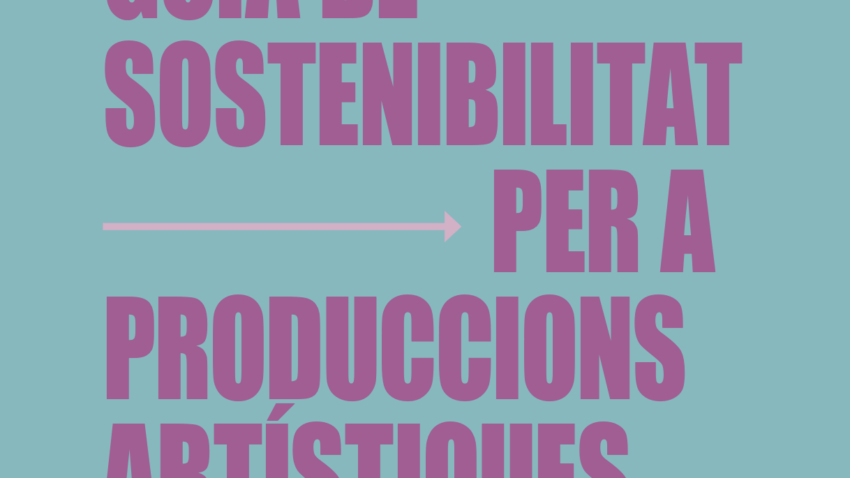
Presentation of the Sustainability Guide for Artistic Productions
With the production of their first show with the company – Swimming poolCia. Lamare-Mireia Galldez was clear that he wanted to create him under a sustainable look. To begin with, he sought other guides and resources, but in 2021 there were very few and they were all in English. Seeing that there was very little documentation and resources on how to do a sustainable show in our country, he decided to make a guide in Catalan with local resources. While the show’s creation and display process was carried out, he tested the English -speaking guides and saw what measures worked and which were to be adapted
The result of this work is the Sustainability Guide for Artistic Productionsfocused by theater companies. While it is true that there are already many more resources-such as the ICEC Plan-, This is a simple guide that illustrates the first actions to take into account sustainability.
Here you can download the Sustainability guide for artistic productions.

Fortunately, many of the artists who try to apply sustainability to our profession have spent years before doing it at home. Once you have discovered some bulk shops and try to buy local produce, wear the handbag always hand and the water canteen in the tote bagthe next step is usually to start ruminating how you can apply all this to your workplace. Suddenly, Sustainability has become a way of understanding your day to day life.
You have the decision made, your next show will be sustainable! With the company you have been flipping around for a long time to that text you would like to do. The call you are interested in comes out and you say it to your colleagues, this is yours. To present the project, you need photos of the show, so come, prepare a photo shoot with an approximate wardrobe and the aesthetics you will want to capture. Introduce and bingo!, You got the residence.
How lucky, he has a budget to pay you two months of creation and rehearsal, a week of technical residence, and premiered in the same room. Where can you start to be sustainable? You have some ideas that you would like to communicate to the company, but you first need to finish training the whole team. In this project you will need a powerful lamp designer, as you want to play with the light aesthetics. You also want to work with that set designer you like, it goes, maybe it tells you yes! And finally … this show will be choral, so you need at least two more performers. It is time to organize a small casting before entering the residence.
Now, with the closed team you can start with rehearsals where you will think about how to do the sustainable show. In the first days you delve into the creation, well, two months of rehearsal is not so much. In the meantime, the person in charge of the distribution of the show begins to think about the premiere: Who must be invited to program next season? What is important now is to look for functions to turn it very much and make the project profitable. Well, if you do not get back, the show will not be economically sustainable, you think. And suddenly, you do not know how, you already have the show mounted and premiered, without having been able to incorporate any measure of sustainability.
This is one of the main difficulties we have as theater companies. There are so few opportunities to carry out projects that when one comes out, there is little time to stop and think well how each small action can take into account the environment. If the photos are needed in two weeks, the last thing is to look for second-hand clothes that fit the proposal. By bad luck, Sustainability requires time and planning.
Another difficulty we have from the performing arts is that the creation of a show is carried out thanks to many organizations: the company, the artists, the creation factories, the exhibition halls, the civic centers and the institutions, among others. There are so many organisms involved that the traceability of everything that does or not sustainable is difficult.
Electricity depends on the creation and exhibition rooms, when they are private – and, when public, on the administration. Economic investment, in most cases, is not safe until after displaying the assembly. And, if you receive a grant, it does not reach partially until the next year. So you can’t guarantee if you can allow you to spend so much money in local stores, often more expensive. Costumes, lighting and set design depend on the team members who in many cases vary from project project. So you ask for a while-often non-existent-make sure they work under this sustainable look.
This guide, then, tries to bring a little light to the matter. There are many things that, as a performing arts company, can be sustainable. To be able to carry them out but You need to break myths mainly and lose the fear of asking.
One of the most rooted myths is that being sustainable is more expensive. But this is not true. Even the actions that a priori think that they face production, under the sustainable gaze, can be reduced. Let’s say you want to avoid buying from multinationals. It seems that now you have to buy that inflatable pool you wanted to try in the rehearsal, but since you have seen that in the local store it costs three times more than bought in Amazon, you decide not to do it. Total, it is only to try it in the rehearsal-you say. So you ask friends and pam! Your best friend says she has one of her when she was a little abandoned in the attic, and that in fact it is good to get rid of it. During the first weeks of rehearsal, the tests and you see that the inflatable pool was not so good idea. Do not use it and you return it to your friend or- with her permission- you sell her second hand. Does it look like an unbelievable example? Well, it’s very real. With the simple purpose of buying at local stores instead of multinationals you have avoided spending on an inflatable pool that you had not ended up using. And when you break this myth you begin to be creative and you find solutions that reduce the budget.
The other change that must have been to lose the fear of asking. Each body- company, residence space, theater and institutions- must see what it depends on. And, in the event that it does not depend, it must be notified to the corresponding one. Everything that is in the hands of others must let them know, communicate what needs and work together to solve it.
Initially, it can be a certain stench asking the exhibition space what energy they have hired. But if we break the ice and ask them, we will not only know if our show has used energy from renewable sources or not, but also that the space will consider hiring renewable energy. Or if, before entering the residence or performing, we ask if they have a drinking water system without bottling. If so, we will be able to inform the team that carries their canteen or glass, and in case we can look for a solution that they can implement from then on.
Although it is a slow task and it depends on many people, Applying sustainability in the performing arts is very much like it at home. Once you break the myths and fears-who does not remember the first time he brought a taper to the market!-you see that everything is easier than it seems. So, what this guide proposes are starting points, small actions that begin to move the gear of sustainability in our sector.

Biography Mireia Giraldez Torras

A graduate in performance at the Barcelona College of Theater at the Laura Jou studio, she is the creator of the Lamare and the vertebral companies where she participates as an actress and producer. Has participated in the productions Swimming pool (Tantarantana), Hay who see Combo resist the arboles (Mutis Festival), What is not said (Nau Ivanow), and in dramatized readings An American life and 7 of a stroke Directed by Marilia Samper (Sala Beckett). In the field of sustainability he has been trained in a self -taught manner, and has come out as a guest in the third chapter of the Podcast Pla_C* Culture for the climate of the ICEC, and has made a speaker in the talk of the Igualada sample “Experiences on environmental sustainability in the performing arts”.









